Multi-Effect Enhanced Raman Scattering Based on Au/ZnO Nanorods Structures
Abstract
1. Introduction
2. Materials and Methods
2.1. Preparation of ZnO Films
2.2. Preparation of ZnO Nanorod Arrays
2.3. Decoration of Au Nanoparticles on As-Prepared Substrates
2.4. Characterization
3. Results and Discussion
3.1. Structure and Morphology
3.2. Raman Detection of R6G
3.3. Discussion of Enhanced Mechanism
4. Conclusions
Author Contributions
Funding
Institutional Review Board Statement
Informed Consent Statement
Data Availability Statement
Conflicts of Interest
References
- Kneipp, K.; Kneipp, H.; Itzkan, I.; Ramachandra, R.D.; Michael, S.F. Surface-enhanced Raman scattering and biophysics. J. Phys. Condens. Matter 2002, 14, 597–624. [Google Scholar] [CrossRef]
- Fleischmann, M.; Hendra, P.J.; Mcquilla, A.J. Raman spectra of pyridzne adsorbed at a silver electrode. Chem. Phys. Lett. 1974, 26, 163–166. [Google Scholar] [CrossRef]
- Jeanmaire, D.L.; Vanduyne, R.P. Surface Raman spectroelectrochemistry: Part I. Heterocyclic, aromatic, and aliphatic amines adsorbed on the anodized silver electrode. J. Electroanal. Chem. 1977, 84, 1–20. [Google Scholar] [CrossRef]
- Kneipp, K.; Hinzmann, G.; Fassler, D. Surface-enhanced Raman scattering of polymethine dyes on silver colloidal particles. Chem. Phys. Lett. 1983, 99, 503–506. [Google Scholar] [CrossRef]
- Shuming, N.; Steven, R.E. Probing single molecules and single nanoparticles by Surface-Enhanced Raman scattering. Science 1997, 275, 1102–1106. [Google Scholar] [CrossRef]
- Michaels, A.M.; Nirmal, M.; Brus, L.E. Surface enhanced Raman spectroscopy of individual Rhodamine 6G molecules on large Ag Nanocrystals. J. Am. Chem. Soc. 1999, 121, 9932–9939. [Google Scholar] [CrossRef]
- Chaney, S.B.; Shanmukh, S.; Dluhy, R.A.; Zhao, Y.P. Aligned silver nanorod arrays produce high sensitivity surface-enhanced Raman spectroscopy substrates. Appl. Phys. Lett. 2005, 87, 031908. [Google Scholar] [CrossRef]
- Talley, C.E.; Jackson, J.B.; Oubre, C.; Grady, N.K.; Hollars, C.W.; Lane, S.M.; Huser, T.R.; Nordlander, P.; Halas, N.J. Surface-Enhanced Raman scattering from individual Au nanoparticles and nanoparticle dimer substrates. Nano Lett. 2005, 8, 1569–1574. [Google Scholar] [CrossRef]
- Huang, Z.L.; Meng, G.W.; Huang, Q.; Yang, Y.J.; Tang, C.L. Improved SERS performance from Au nanopillar arrays by abridging the pillar tip spacing by Ag sputtering. Adv. Mater. 2010, 22, 4136–4139. [Google Scholar] [CrossRef]
- Chen, H.Y.; Lin, M.H.; Wang, C.Y.; Chang, Y.M.; Gwo, S. Large-Scale hot spot engineering for quantitative SERS at the single-molecule scale. J. Am. Chem. Soc. 2015, 137, 13698–13705. [Google Scholar] [CrossRef]
- Mosier-Boss, P.A. Review of SERS substrates for chemical sensing. Nanomaterials 2017, 7, 142. [Google Scholar] [CrossRef] [PubMed]
- Rickard, J.J.S.; Di-Pietro, V.; Smith, D.J.; Davies, D.J.; Belli, A.; Oppenheimer, P.G. Rapid optofluidic detection of biomarkers for traumatic brain injury via surface-enhanced Raman spectroscopy. Nat. Biomed. Eng. 2020, 4, 610–623. [Google Scholar] [CrossRef] [PubMed]
- Zhang, T.; Quan, X.; Cao, N.; Zhang, Z.; Li, Y. Label-Free detection of DNA via Surface-Enhanced Raman spectroscopy using Au@Ag nanoparticles. Nanomaterials 2022, 12, 3119. [Google Scholar] [CrossRef] [PubMed]
- Smith, W.E. Practical understanding and use of surface enhanced Raman scattering/surface enhanced resonance Raman scattering in chemical and biological analysis. Chem. Soc. Rev. 2008, 37, 955–964. [Google Scholar] [CrossRef] [PubMed]
- Yoshida, K.; Itoh, T.; Tamaru, H.; Biju, V.; Ishikawa, M.; Ozaki, Y. Quantitative evaluation of electromagnetic enhancement in surface-enhanced resonance Raman scattering from plasmonic properties and morphologies of individual Ag nanostructures. Phys. Rev. B 2010, 81, 115406. [Google Scholar] [CrossRef]
- Yoon, I.; Kang, T.; Choi, W. Single nanowire on a film as an efficient SERS-Active platform. J. Am. Chem. Soc. 2009, 131, 758–762. [Google Scholar] [CrossRef]
- Shen, W.; Lin, X.; Jiang, C.Y.; Li, C.Y.; Lin, H.X.; Huang, J.T.; Wang, S.; Liu, G.K.; Yan, X.M.; Zhong, Q.L.; et al. Reliable quantitative SERS analysis facilitated by Core-Shell nanoparticles with embedded internal standards. Angew. Chem. Int. Ed. 2015, 127, 7416–7420. [Google Scholar] [CrossRef]
- Baohua, Z.; Haishui, W.; Lehui, L.; Guo, Z.; Xiaoli, C. Large-area Silver-coated Silicon nanowire arrays for molecular sensing using Surface-Enhanced Raman spectroscopy. Adv. Funct. Mater. 2008, 18, 2348–2355. [Google Scholar] [CrossRef]
- Jianfeng, L.; Yifan, H.; Yong, D.; Zhilin, Y.; Songbo, L.; Xiaoshun, Z.; Zhiyou, Z.; Deyin, W.; Bin, R.; Zhonglin, W.; et al. Shell-isolated nanoparticle-enhanced Raman spectroscopy. Nature 2010, 464, 392–395. [Google Scholar] [CrossRef]
- Hatab, N.A.; Hsueh, C.H.; Gaddis, A.L.; Retterer, S.T.; Li, J.H.; Eres, G.; Zhang, Z.Y.; Gu, B.H. Free-standing optical gold bowtie nanoantenna with variable gap size for enhanced Raman spectroscopy. Nano Lett. 2010, 10, 4952–4955. [Google Scholar] [CrossRef]
- Ke, M.; Jonathan, M.Y.; Nilam, C.S.; Matthew, R.G.; Richard, P.V.D. In vivo, transcutaneous glucose sensing using Surface-Enhanced spatially offset Raman spectroscopy: Multiple rats, improved hypoglycemic accuracy, low incident power, and continuous monitoring for greater than 17 Days. Anal. Chem. 2011, 83, 9146–9152. [Google Scholar] [CrossRef]
- Fu, Q.; Zhan, Z.B.; Dou, J.X.; Zheng, X.Z.; Xu, R.; Wu, M.H.; Lei, Y. Highly reproducible and sensitive SERS substrates with Ag inter-nanoparticle gaps of 5 nm fabricated by ultrathin aluminum mask technique. ACS Appl. Mater. Interfaces 2015, 7, 13322–13328. [Google Scholar] [CrossRef]
- Liu, Y.; Kim, M.; Cho, S.H.; Jung, Y.S. Vertically aligned nanostructures for a reliable and ultrasensitive SERS-active platform: Fabrication and engineering strategies. Nano Today 2021, 37, 101063. [Google Scholar] [CrossRef]
- Kuang-Hsuan, Y.; Chia-Ming, C. Surface-enhanced Raman scattering-active Au/TiO2 films prepared by electrochemical and photochemical methods. Mater. Res. Bull. 2013, 48, 372–377. [Google Scholar] [CrossRef]
- Liu, J.; Chen, L.Y.; Duan, B.H.; Duan, C.Y. Engineering aggregation-induced SERS-active porous Au@ZnS multi-yolk–shell structures for visualization of guest species loading. RSC Adv. 2016, 6, 38690–38696. [Google Scholar] [CrossRef]
- Ji, W.; Zhao, B.; Ozaki, Y. Semiconductor materials in analytical applications of surface-enhanced Raman scattering. J. Raman Spectrosc. 2016, 47, 51–58. [Google Scholar] [CrossRef]
- Bai, S.; Du, Y.; Wang, C.; Wu, J.; Sugioka, K. Reusable surface-enhanced Raman spectroscopy substrates made of Silicon nanowire array coated with silver nanoparticles fabricated by metal-assisted chemical etching and photonic reduction. Nanomaterials 2019, 9, 1531. [Google Scholar] [CrossRef]
- Jue, M.; Lee, S.; Paulson, B.; Namgoong, J.M.; Yu, H.Y.; Kim, G.; Jeon, S.; Shin, D.-M.; Choo, M.-S.; Joo, J.; et al. Optimization of ZnO nanorod-based surface enhanced Raman scattering substrates for bio-applications. Nanomaterials 2019, 9, 447. [Google Scholar] [CrossRef]
- Fernando, J.F.S.; Shortell, M.P.; Firestein, K.L.; Zhang, C.; Larionov, K.; Popov, Z.I.; Sorokin, P.B.; Bourgeois, L.; Waclawik, E.R.; Golberg, D.V. Photocatalysis with Pt–Au–ZnO and Au–ZnO hybrids: Effect of charge accumulation and discharge properties of metal nanoparticles. Langmuir 2018, 34, 7334–7345. [Google Scholar] [CrossRef]
- Tang, H.B.; Meng, G.W.; Huang, Q.; Zhang, Z.; Huang, Z.L.; Zhu, C.H. Arrays of cone-shaped ZnO nanorods decorated with Ag nanoparticles as 3D surface-enhanced Raman scattering substrates for rapid detection of trace polychlorinated biphenyls. Adv. Funct. Mater. 2011, 22, 218–224. [Google Scholar] [CrossRef]
- Huang, Q.L.; Liu, S.Z.; Wei, W.X.; Yan, Q.X.; Wu, C.L. Selective synthesis of different ZnO/Ag nanocomposites as surface enhanced Raman scattering substrates and highly efficient photocatalytic catalysts. RSC Adv. 2015, 5, 27075–27081. [Google Scholar] [CrossRef]
- Huo, D.X.; Chen, B.; Li, M.T.; Meng, G.W.; Lei, Y.; Zhu, C.H. Template-assisted fabrication of Ag-nanoparticles@ZnO-nanorods array as recyclable 3D surface enhanced Raman scattering substrate for rapid detection of trace pesticides. Nanotechnology 2021, 32, 145302. [Google Scholar] [CrossRef] [PubMed]
- Chen, Z.C.; Zhu, L.; Ma, Z.P.; Wang, M.L.; Zhao, R.; Zou, Y.Y.; Fan, Y.J. Derivatization reaction-based surface-enhanced Raman scattering for detection of methanol in transformer oil using Ag/ZnO composite nanoflower substrate. Appl. Surf. Sci. 2022, 604, 154442. [Google Scholar] [CrossRef]
- Dey, P.; Baumann, V.; Rodríguez-Fernández, J. Gold nanorod assemblies: The roles of hot-spot positioning and anisotropy in plasmon coupling and SERS. Nanomaterials 2020, 10, 942. [Google Scholar] [CrossRef]
- Cong, S.; Liu, X.H.; Jiang, Y.X.; Zhang, W.; Zhao, Z.G. Surface enhanced Raman scattering revealed by interfacial charge-transfer transitions. Innovation 2020, 1, 100051. [Google Scholar] [CrossRef]
- Wang, C.; Guo, X.; Fu, Q. TiO2 thickness-dependent charge transfer in an ordered Ag/TiO2/Ni nanopillar arrays based on surface-enhanced Raman scattering. Materials 2022, 15, 3716. [Google Scholar] [CrossRef]
- Tang, X.; Fan, X.C.; Yao, L.; Li, G.Q.; Li, M.Z.; Zhao, X.; Hao, Q.; Qiu, T. Electromagnetic mechanisms or chemical mechanisms? role of interfacial charge transfer in the plasmonic metal/semiconductor heterojunction. J. Phys. Chem. Lett. 2022, 13, 7816–7823. [Google Scholar] [CrossRef]
- Zhu, Q.X.; Xu, C.X.; Wang, D.L.; Liu, B.; Qin, F.F.; Zhu, Z.; Liu, Y.J.; Zhao, X.W.; Shi, Z.L. Femtomolar response of plasmon-coupled ZnO/Graphene/Silver hybrid whispering-gallery mode microcavity for SERS sensing. J. Mater. Chem. C 2019, 7, 2710. [Google Scholar] [CrossRef]
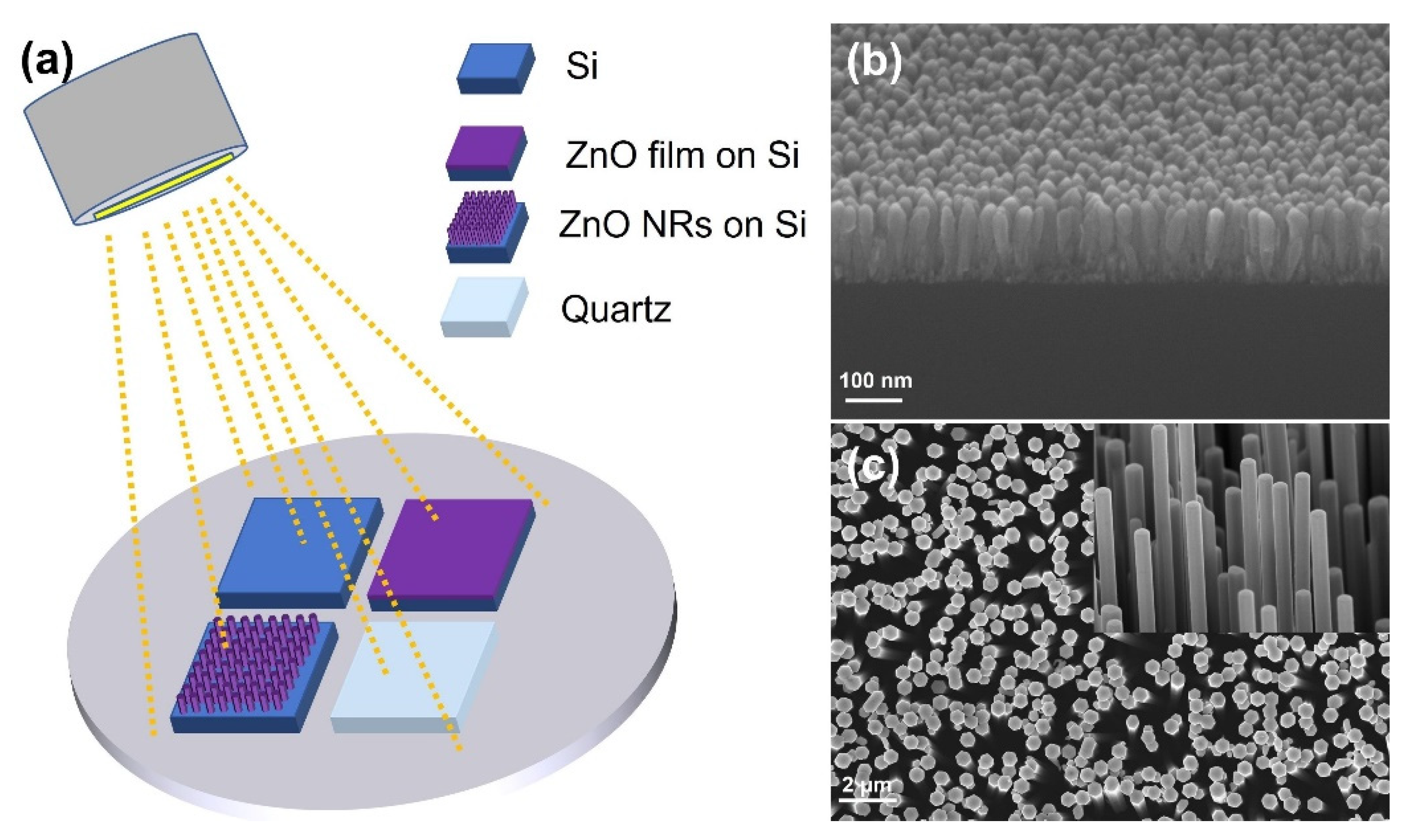


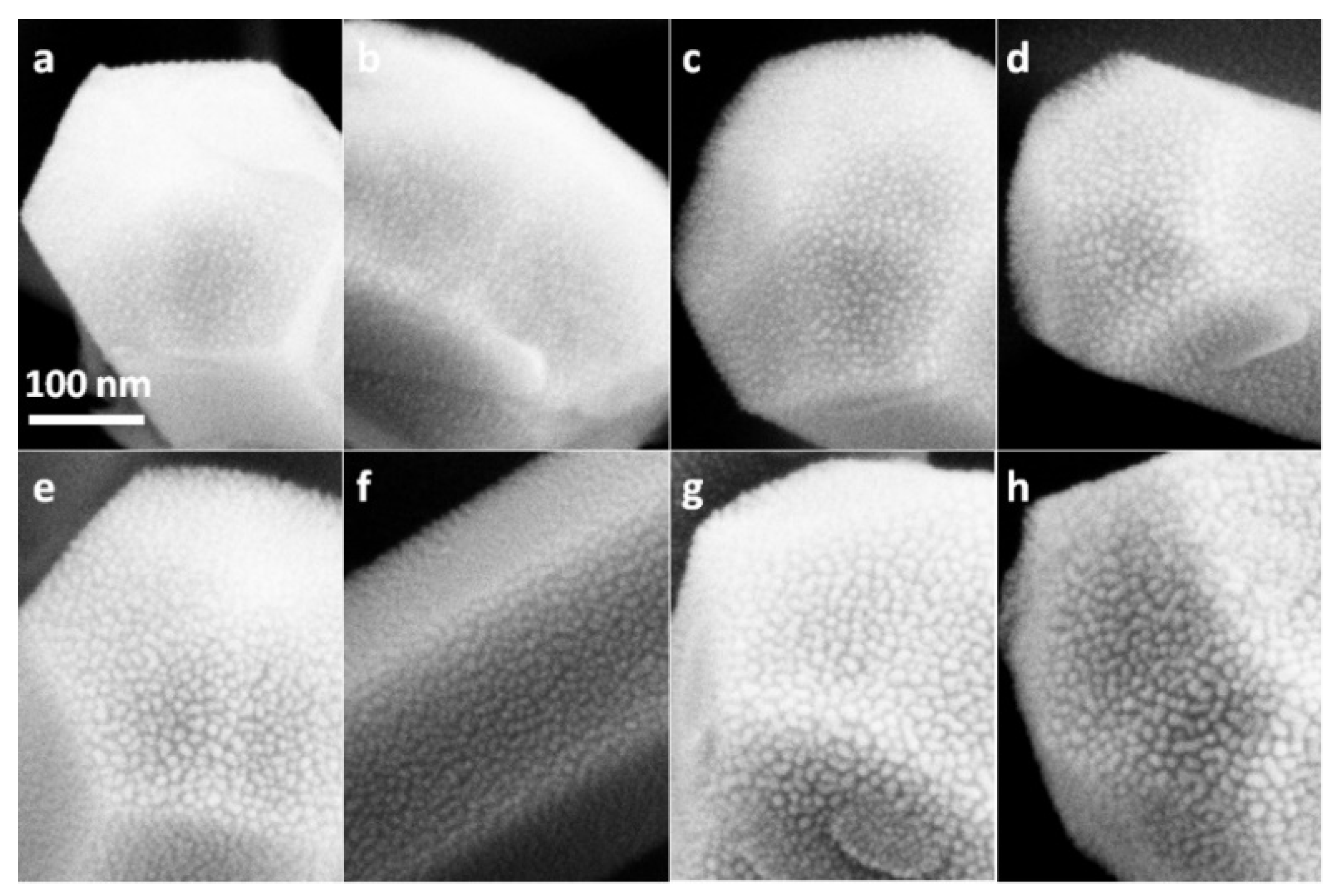
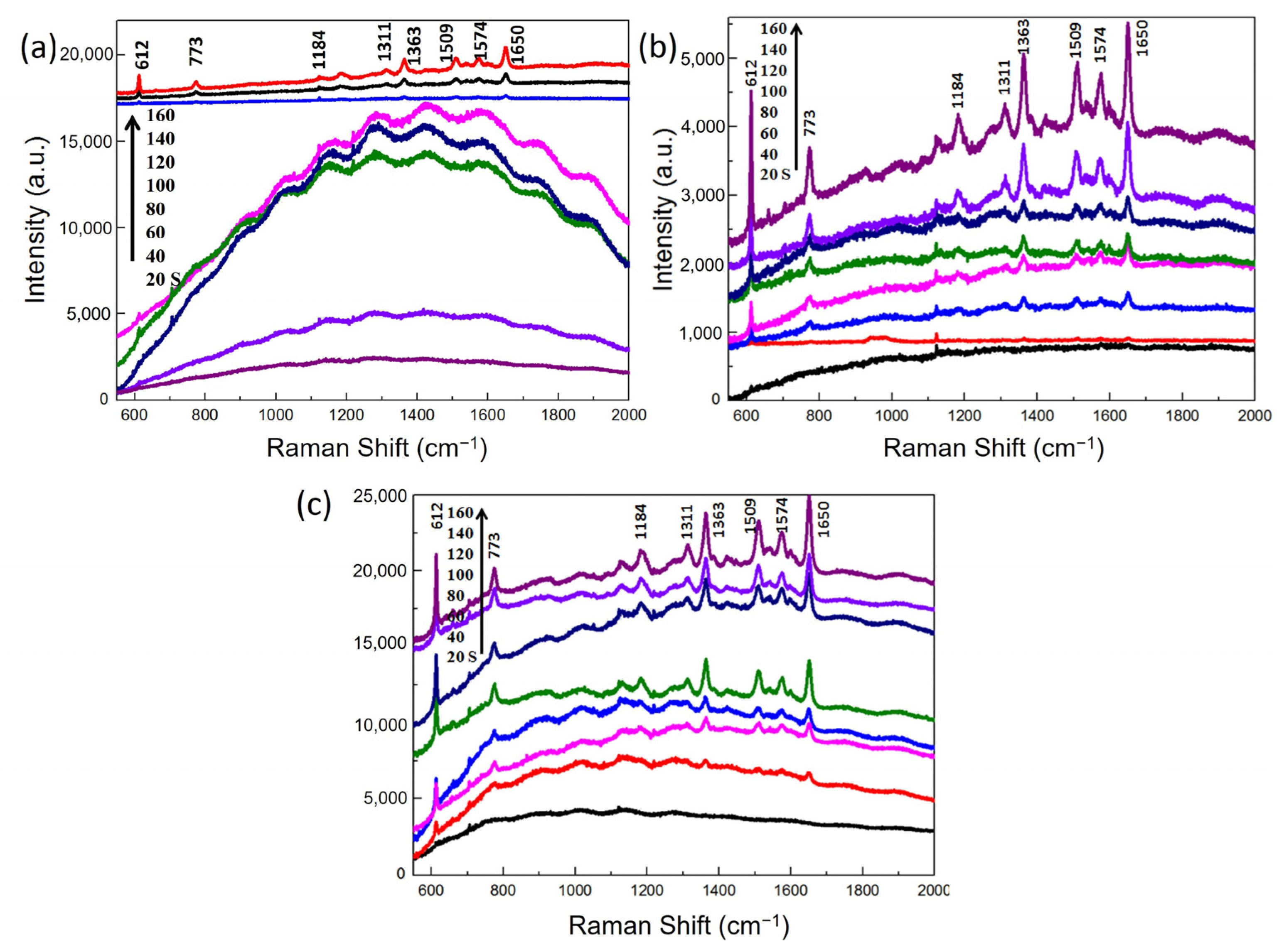

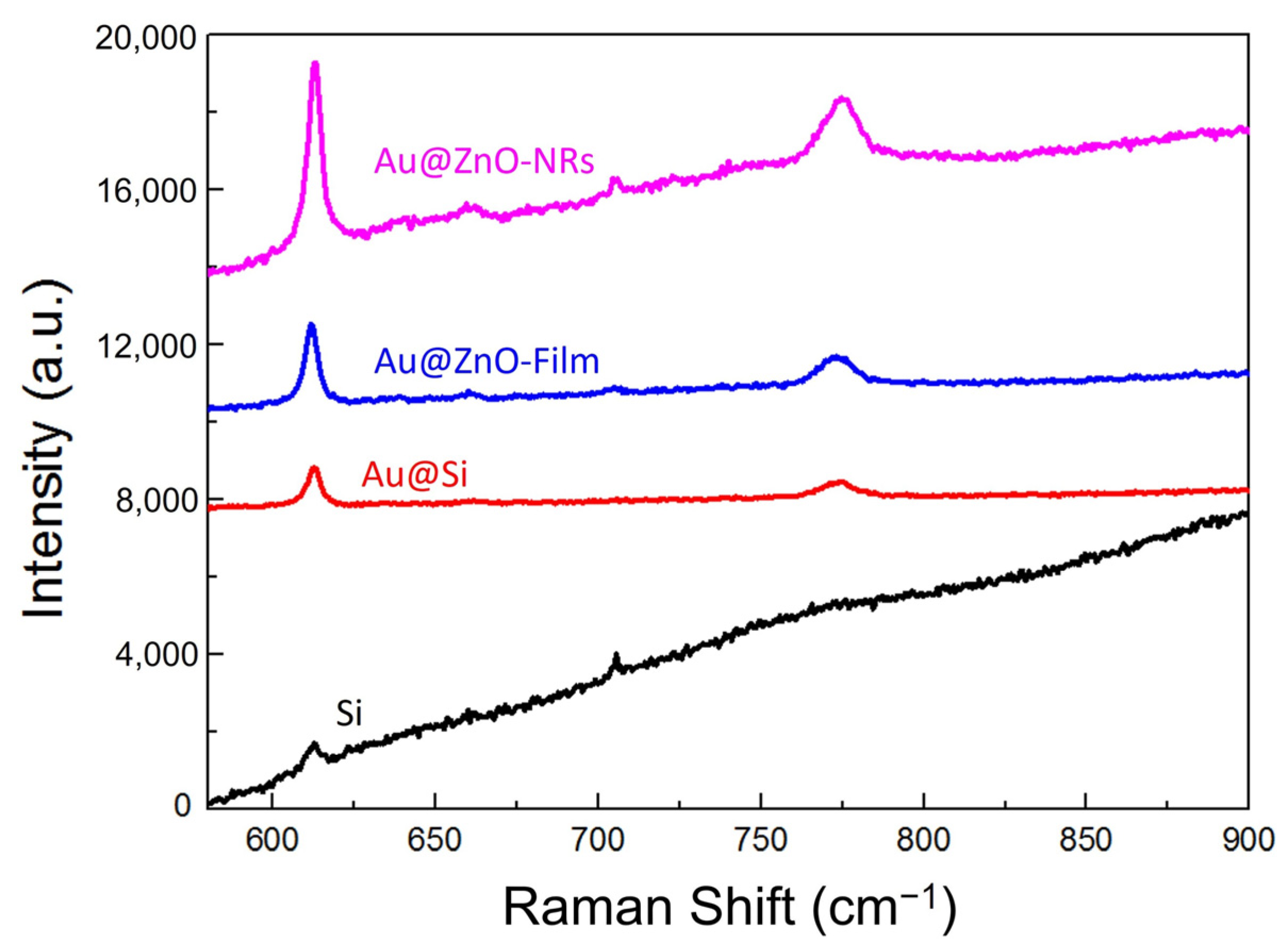
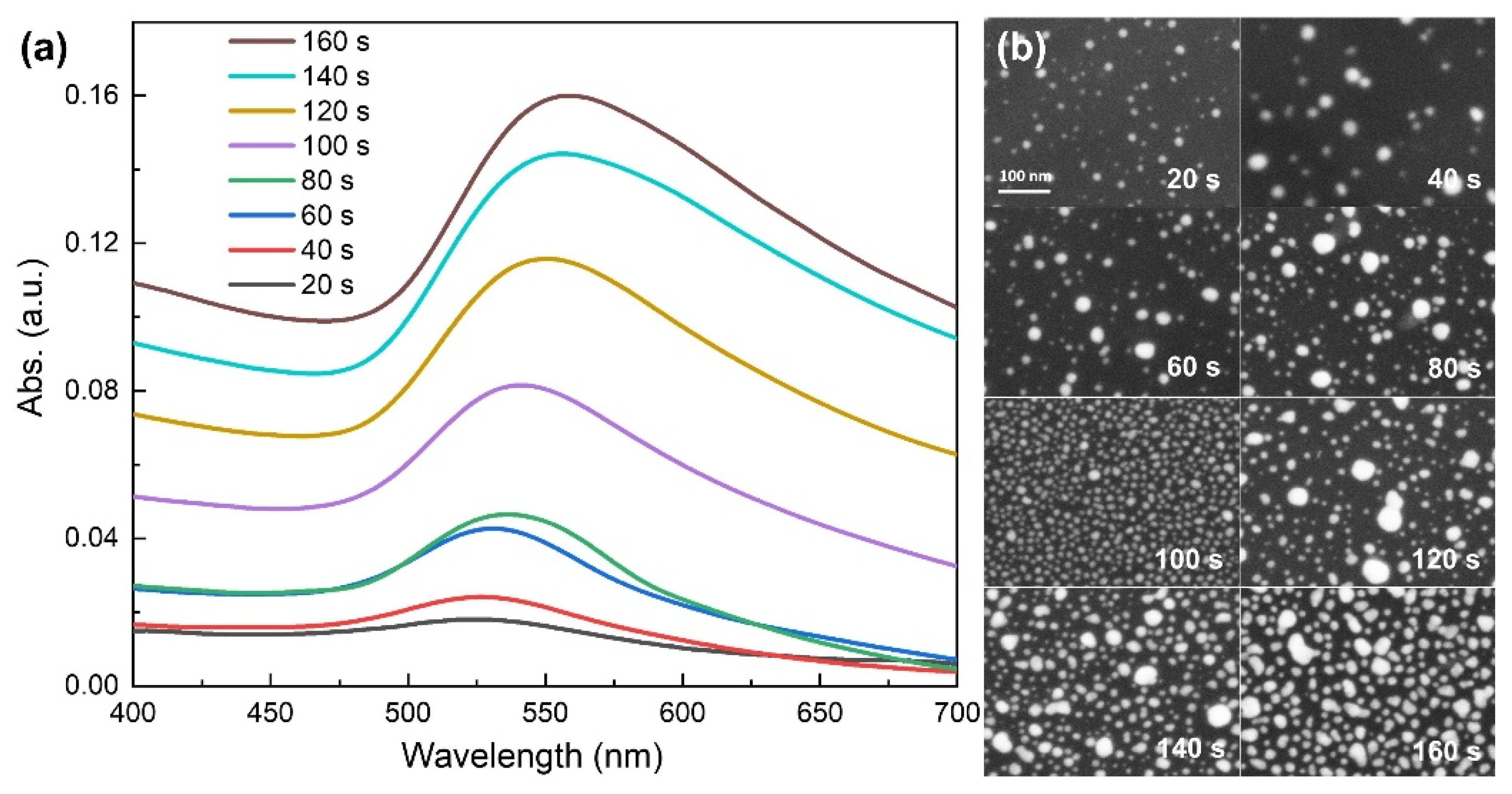
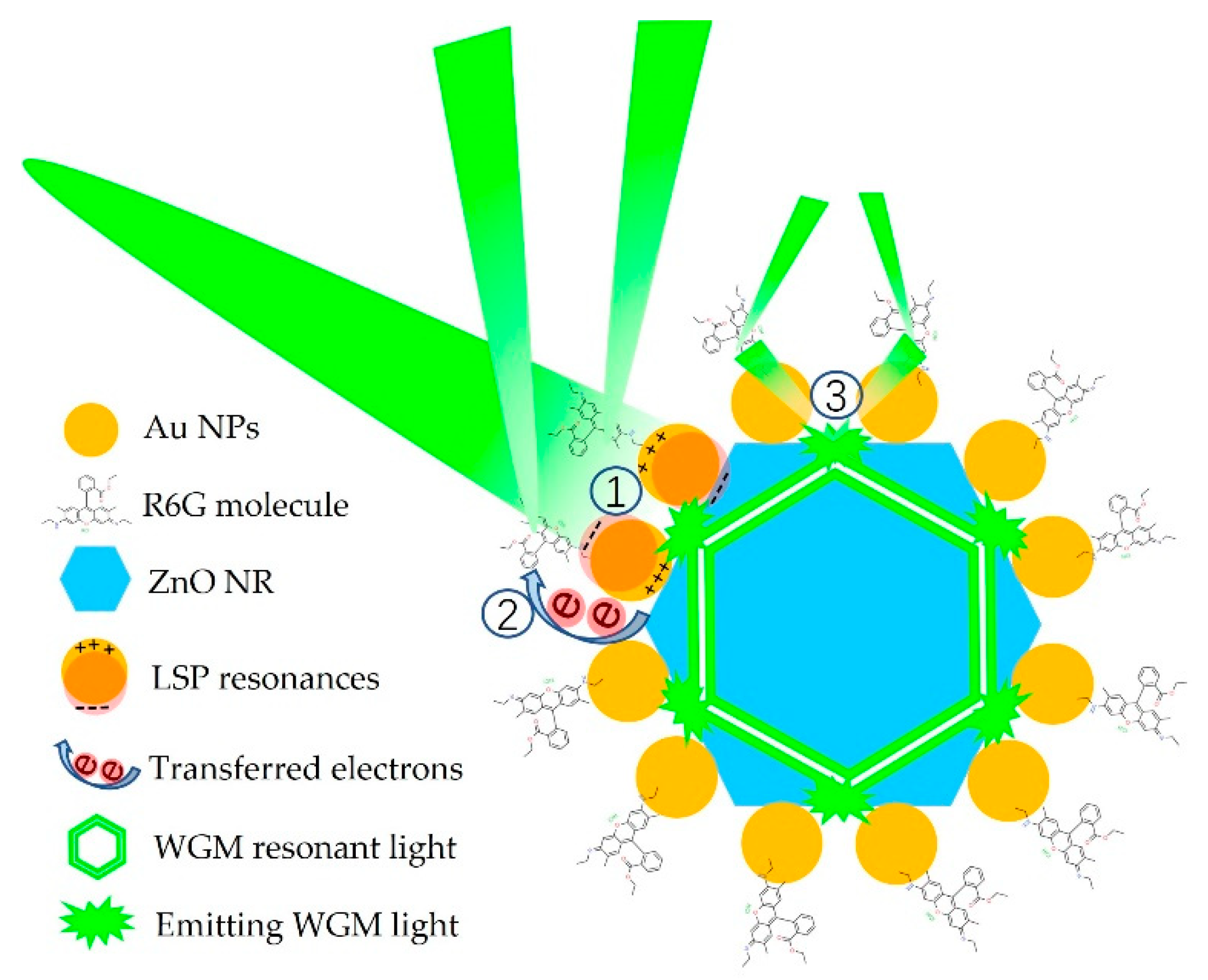
Publisher’s Note: MDPI stays neutral with regard to jurisdictional claims in published maps and institutional affiliations. |
© 2022 by the authors. Licensee MDPI, Basel, Switzerland. This article is an open access article distributed under the terms and conditions of the Creative Commons Attribution (CC BY) license (https://creativecommons.org/licenses/by/4.0/).
Share and Cite
Lin, Y.; Zhang, J.; Zhang, Y.; Yan, S.; Nan, F.; Yu, Y. Multi-Effect Enhanced Raman Scattering Based on Au/ZnO Nanorods Structures. Nanomaterials 2022, 12, 3785. https://doi.org/10.3390/nano12213785
Lin Y, Zhang J, Zhang Y, Yan S, Nan F, Yu Y. Multi-Effect Enhanced Raman Scattering Based on Au/ZnO Nanorods Structures. Nanomaterials. 2022; 12(21):3785. https://doi.org/10.3390/nano12213785
Chicago/Turabian StyleLin, Yi, Jun Zhang, Yalan Zhang, Sai Yan, Feng Nan, and Yanlong Yu. 2022. "Multi-Effect Enhanced Raman Scattering Based on Au/ZnO Nanorods Structures" Nanomaterials 12, no. 21: 3785. https://doi.org/10.3390/nano12213785
APA StyleLin, Y., Zhang, J., Zhang, Y., Yan, S., Nan, F., & Yu, Y. (2022). Multi-Effect Enhanced Raman Scattering Based on Au/ZnO Nanorods Structures. Nanomaterials, 12(21), 3785. https://doi.org/10.3390/nano12213785



